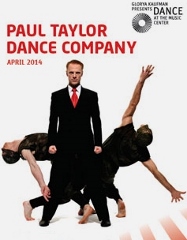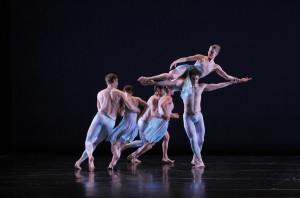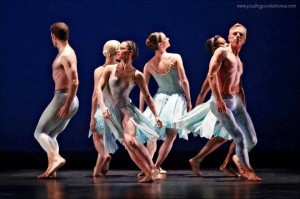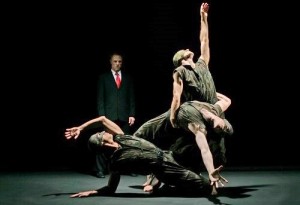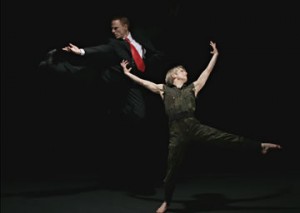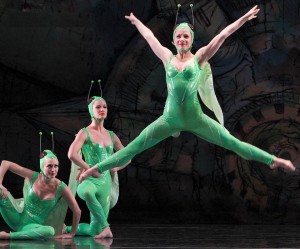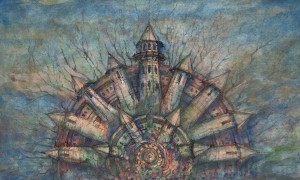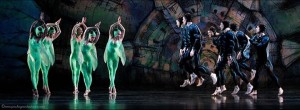TAYLOR-MADE
When a visiting dance company plays Los Angeles, it usually offers pieces which cover both the old and the new. And so it is with Paul Taylor, who presented last weekend at the Chandler three works created between 1978 and 2011. The triptych certainly speaks to the inventiveness of Taylor, who has created 139 dances since 1954, and the variety of the program displays the aspects which make Taylor, who will be 84 in July, one of the iconic figures in American dance. Alternating between dark and whimsical, all of the Taylor themes were on display: Life and death; the natural world; love and sexuality; and American history. I suspect the evening would satisfy those who have never seen Taylor’s work before (it’s been 10 years since the company last visited L.A.), but for die-hards, the magic was intermittent at best.
“Airs” is a deliriously sensual and agreeable piece of candy from 1978. The bare-chested men are in sexy, tight, thermal underwear pants, while the women are clad in powder-blue summer dresses that lean towards lingerie (costumes by Gene Moore). Set to nine excerpts from works of G.F. Handel (prerecorded, as was all the music), the comely ensemble flutters, leaps and pirouettes in Jennifer Tipton’s dappled lighting as if they were petals blown about by the breeze. Entirely attractive and pleasingly proportioned, the piece’”which is like a Grecian Urn sprung to graceful life’”celebrates many styles: Reels, gavottes, classical, modern, Gene Kelly, and a Regency dance one would expect at a ball right out of Jane Austen. There is a lavish and easy-going air to the entire seven-member affair as the dancers merge from one beautiful configuration to another. One hearty duet between Eran Bugge and senior dancer Michael Trusnovec becomes stylish and delicate while another pas de deux with Jamie Rae Walker and Robert Kleinendorst is an entirely whimsical parrying of prances and leaps.
The issue is that we’re not getting a full-out “A” cast, which resides in Taylor’s home base of New York. In order for “Airs” to be magical, the men need more height and grace, the women need to synch up their lines, and lifts should appear weightless at all times. This is what happens when a Dance Master rehearses a touring company; without the stamp of the original choreographer, a groundbreaking work appears a bit cliché. Michelle Fleet stood out as the dancer who realized the piece’s potential; she had grace, poise, strength, and tension. Unfortunately, she only made the lack of synchronization and earthbound dancing all the more obvious.
Although it’s not satiric or comically expressionistic like Kurt Jooss’s “The Green Table,” “Banquet of Vultures” (2005) also depicts the futility of war and the horrors it causes. The context here isn’t war in general; the haunting piece is clearly an anti-war statement about the U.S.’s involvement in Iraq. Introduced two years after we entered, or rather began, the war, Taylor’s thrust is on the military-industrial complex, evidenced by the central figure of a suited man (Trusnovec, who also served as rehearsal director) in a blood-red tie. Taylor stated in the past that this man represents President George W. Bush, but one can also glean from his presence the political sidesteppers and corporations which stand to profit from war. The U.S. may have completed its withdrawal of military personnel from Iraq in 2011, but the fact that insurgency is ongoing (not to mention recent events in Crimea), “Banquet of Vultures” has a mighty resonance.
Minimalist composer Morton Feldman’s mournful, eerie, ominous and slow-paced Oboe and Orchestra (1976) sets the tone for the drudgery and seeming endlessness of war on a dimly lit, hazy stage (again, Tipton). Dancers, some carrying candles, are costumed by Santo Loquasto in dark-green, sleeveless camouflage, bandanas, and stocking masks, going beyond mere suggestion of soldiers and terrorists. There is no interpretive dance here as the frenzied movement literally depicts the aspects of battle, such as marching, running, crawling, and combative entanglements.
At one point, the man in the suit, with his body parts lashing out in all directions like a creepy rogue robot, knocks off dancers one-by-one, and then hunts down a lone grieving woman, tossing her about and beating her to death with her own candle. Some of the war-reenactment movement was a bit too on the money, making me feel manipulated more than devastated, but the piece no doubt makes a powerful, visceral statement akin to a quote by John Davidson in the program: “For war breeds war again.” To hammer that sentiment home, another man in a dark suit (Kleinendorst) begins stealthily walking towards us just prior to curtain, searing a spooky image which lingers long after the other scenes fade.
The insect-like movement of the soldiers in “Vultures” had nothing on “Gossamer Gallants,” set to Dances from BedÅ™ich Smetana’s comic opera, The Bartered Bride (1866). Coincidentally, both Taylor’s piece and the music have something in common with Disney’s Fantasia (1940), which spoofed classical ballet in its “Dance of the Hours” segment: Smetana’s music has the same frenzied, driven jocularity as Ponchielli’s oft-imitated score (which was first performed ten years after Bride in 1876), but instead of Fantasia’s anthropomorphized elephants and ostriches, the eleven-member Taylor company portrays fireflies during mating season.
Taylor was one of the first choreographers to bring athleticism to ballet, and it’s more than evident in this comedic but silly work, first performed in 2011. While it’s more enjoyable and a far cry better than so many works these days where I have no idea what’s going on, the dancers aren’t enough like insects to constantly amuse, and the generic personalities and repetitive movements keep it from soaring.
Loquasto’s winged costumes with skull caps are a hoot: The boy bugs have electric blue muscles painted on black spandex, and the girls are in bright, fluorescent green spandex with long wings. We watch the rowdy guys whooping it up, showing off their prowess, while the girls sashay coquettishly with shoulder-popping and wrists on hips. After this stereotypical ritual is displayed, the tables are turned when the predatory girls turn against the boys, ending with a pile of departed males. When dancers executed insect-like handwork, the piece became fascinating and exciting, but these moments were few. Other than that we are left to ponder just how far “adorable” can go.
photos by Tom Caravaglia and Paul B. Goode
Paul Taylor Dance Company
Glorya Kaufman Presents Dance at The Music Center
The Music Center’s Dorothy Chandler Pavilion
135 N. Grand Avenue
played April 11 – 13, 2014
for tickets to future events, visit The Music Center
for more info, visit Paul Taylor Dance
